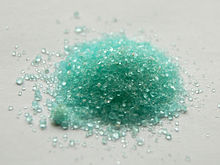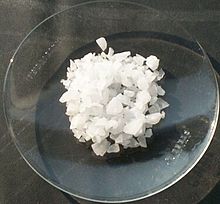Vitriolis the generalchemicalname encompassing a class ofchemical compoundscomprisingsulfatesof certain metals – originally,ironorcopper.Those mineral substances were distinguished by their color, such as green vitriol for hydratediron(II) sulfateand blue vitriol for hydratedcopper(II) sulfate.[1]
These materials were found originally as crystals formed by evaporation of groundwater that percolated throughsulfideminerals and collected in pools on the floors of oldmines.The wordvitriolcomes from the Latin wordvitriolus,meaning "small glass", as those crystals resembled small pieces of colored glass.
Oil of vitriol was an old name for concentratedsulfuric acid,which was historically obtained through the dry distillation (pyrolysis) of vitriols. The name, abbreviated to vitriol, continued to be used for this viscous liquid long after the minerals came to be termed "sulfates". The figurative termvitriolicin the sense of "harshly condemnatory" is derived from the corrosive nature of this substance.
| Vitriol | Chemical | Comment | Formula | Image |
|---|---|---|---|---|
| Black vitriol | Sulfate • Heptahydrate ( Hydrated Sulfate)[A] | [Cu,Mg,Fe,Mn,Co,Ni]SO4·7H2O[B] | ||
| Blue vitriol/Vitriol of Cyprus/Roman vitriol[2] | copper(II) sulfate | pentahydrate | CuSO4·5H2O | 
|
| Green vitriol/Copperas | iron(II) sulfate | heptahydrate | FeSO4·7H2O | 
|
| Oil of vitriol/Spirit of vitriol | sulfuric acid | acid | H2SO4 |  |
| Red vitriol | cobalt(II) sulfate | heptahydrate | CoSO4·7H2O |  |
| Sweet oil of vitriol | diethyl ether | Not a sulfate, but can be synthesized from sulfuric acid and ethanol[3] | CH3-CH2-O-CH2-CH3 | 
|
| Vitriol of argile/Vitriol of clay | aluminium sulfate | alum | Al2(SO4)3 | 
|
| Vitriol of Mars | iron(III) sulfate | Ferric sulfate | Fe2(SO4)3 | 
|
| White vitriol | zinc sulfate | heptahydrate | ZnSO4·7H2O | 
|
| AMany websites state that black vitriol "is a mixture of iron sulfate and iron sulfite", but none give a reference of any sort. The book,Chemistry, Inorganic & Organic, with Experiments,by Bloxam[4]is a published, reliable reference for the composition ofblack vitriol,and it states on page 513, "The formula of black vitriol may be written [CuMgFeMnCoNi]SO4·7H2O, the six isomorphous metals being interchangeable without altering the general character of the salt. " |
| B"Any combination of these elements may be found in black vitriol."[4] |
History
editThe study of vitriol began duringancient times.Sumerianshad a list of types of vitriol that they classified according to the substances' color. Some of the earliest discussions of the origin and properties of vitriol is in the works of the Greek physicianDioscorides(first century AD) and the Roman naturalistPliny the Elder(23–79 AD).Galenalso discussed its medical use. Metallurgical uses for vitriolic substances were recorded in the Hellenistic alchemical works ofZosimos of Panopolis,in the treatisePhisica et Mystica,and theLeyden papyrus X.[5]
Medieval Islamic chemistslikeJābir ibn Ḥayyān(died c. 806–816 AD, known in Latin as Geber),Abū Bakr al-Rāzī(865–925 AD, known in Latin as Rhazes),Ibn Sina(980–1037 AD, known in Latin as Avicenna), andMuḥammad ibn Ibrāhīm al-Watwat(1234–1318 AD) included vitriol in their mineral classification lists.[6]
Sulfuric acid was termed "oil of vitriol" by medieval European alchemists because it was prepared by roasting "green vitriol" (iron(II) sulfate) in an ironretort.The first vague allusions to it appear in the works ofVincent of Beauvais,in theCompositum de Compositisascribed to SaintAlbertus Magnus,and inpseudo-Geber'sSumma perfectionis(all thirteenth century AD).[7]
References
edit- ^"Vitriol"entry in the online Encyclopaedia Britannica. Accessed on 2020-08-28.
- ^Roman vitriol on Chembk CAS Database
- ^"Synthesis of Ethers".
- ^abBloxam, Charles Loudon; Bloxam, Arthur G.; Lewis, S. Judd (1913). "Copper, Cu = 63.57".Chemistry, Inorganic & Organic, with Experiments(Tenth ed.). Philadelphia: P. Blakiston's Son & Co. p.513.
The formula of black vitriol may be written [CuMgFeMnCoNi]SO4·7H2O, the six isomorphous metals being interchangeable without altering the general character of the salt.
- ^Karpenko, Vladimír; Norris, John A. (2002)."Vitriol in the History of Chemistry".Chemické listy.96(12): 997–1005.
- ^Karpenko & Norris 2002,pp. 999–1000.
- ^Karpenko & Norris 2002,pp. 1002–1004.